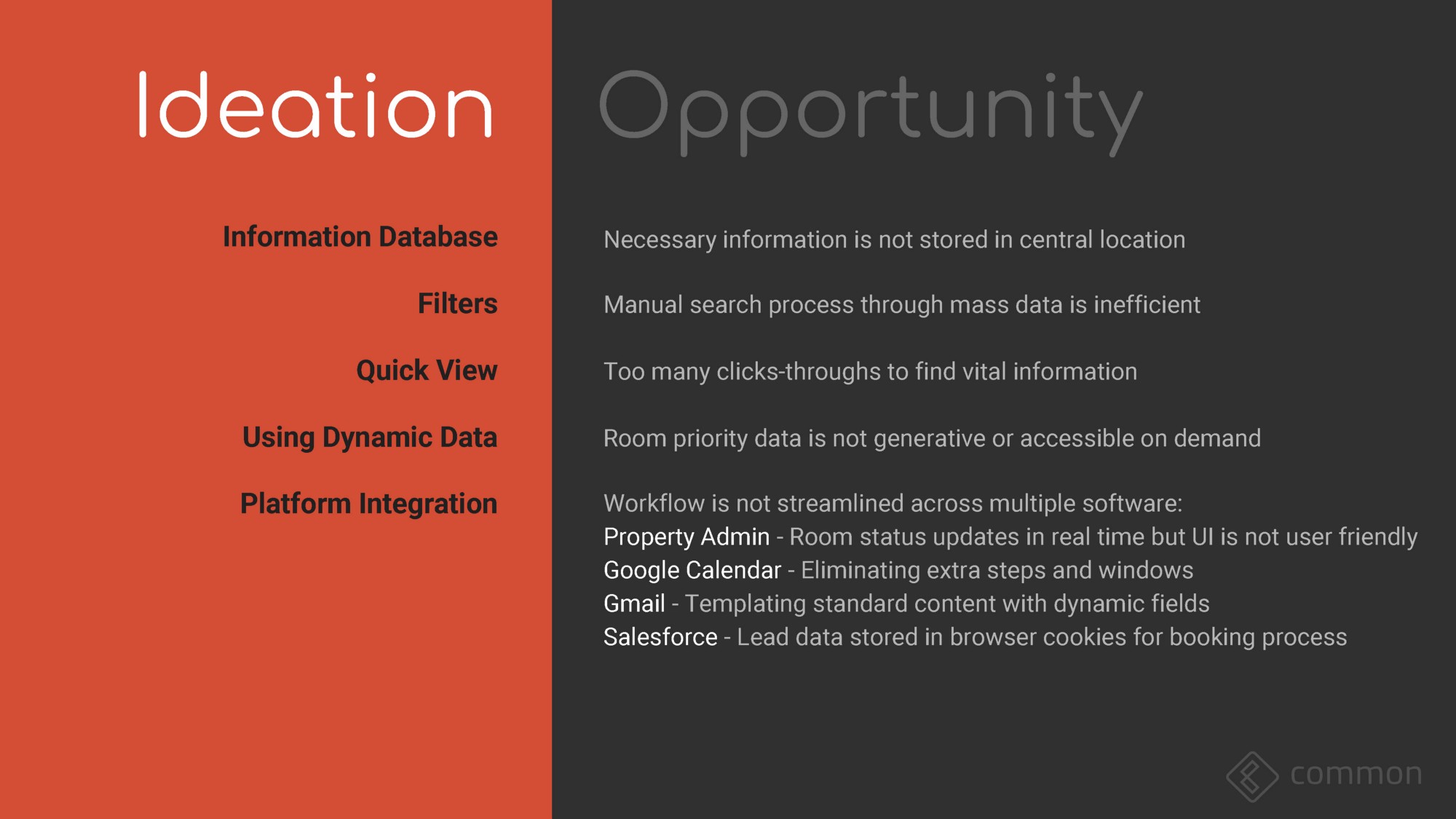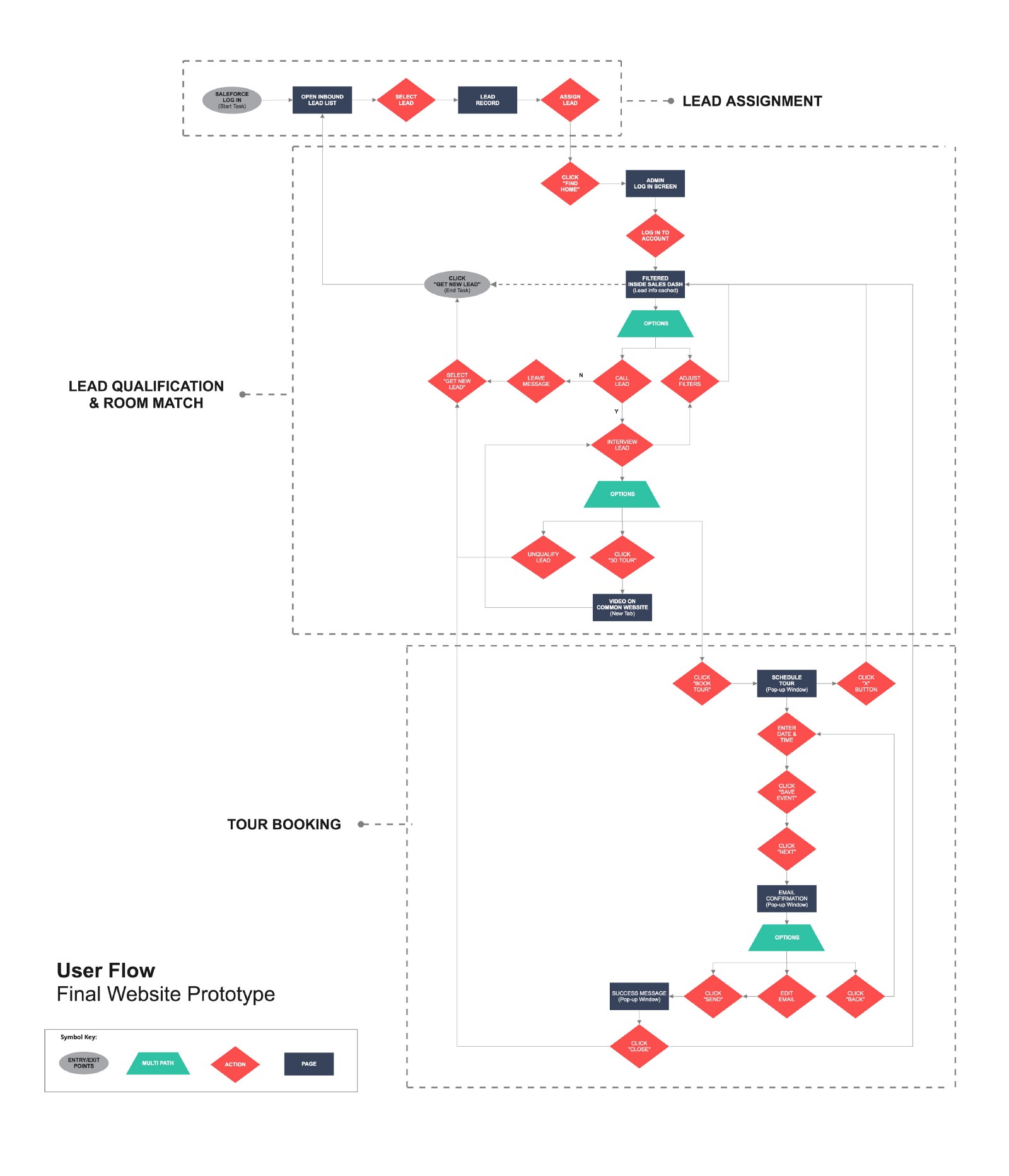
Common
Insides Sales Dash for Common - Co-Living Done Right


Project Scope
Common has partnered with UnCommon Creative to conduct full research analysis of their current lead conversion process with focus on reducing customer pain points and increasing efficiency of their Internal Sales Team.
Problem Statement
As Common is growing quickly, it’s Inside Sales team feels the need to create their own quick fixes to match their customers to properties more efficiently. Information is spread out and not updated in a timely manner, which makes their job much more inefficient and potentially inaccurate.
Opportunity
Common’s current process lacks standardization, full platform functionalities and a centralized resource to enable their Inside Sales team to access necessary information on demand. For sustainable growth, there is an opportunity to design a solution that provides dynamic data in real time, a centralized database, platform integration and streamlined communication to immediately increase efficiency and customer engagement.
Project Team
UnCommon Creative | Susana Charm, Chris Brause, James White
My Role: Scrum Master, UX Researcher/Interviewer, Designer
Deliverables
Conducted full UX research analysis of current lead conversion process and delivered Research Report of findings, for improving service design to increase property tour bookings
Designed new Internal Sales Dashboard solution. Key features, detailed in Specification Document, include data centralization and filtering, dynamic data mapping, automation and feature integration, to increase efficiency and streamline workflow between cross-functional teams.
Tools & Methods Used: Contextual Inquiry, User Interviews, Process Flow and User Journey, User Flow, Usability Testing, Paper Prototype, Mid/Hi-Fidelity Wireframes, Adobe Illustrator, Sketch + Craft Plugin, inVision, Trello
Project Timeline: 2 Week Sprint

Background
Founded in 2015 by Brad Hargreaves, the co-living startup offers fully furnished apartments across New York, the Bay Area, Chicago and Washington DC, with plans of expanding nationwide. With rapid growth in business, Common scales at a fast pace in continued expansion of their property base and internal sales force.

User Insights & Technical Constraints
Of the seven people we interviewed, not each were necessarily end users, they all have an effect on how the current system is used and how the Inside sales team does their job. Each interview showed how drastically each department (and sometimes each individual) uses the current system and where their frustrations lie. We documented key findings from each person we spoke with and created an affinity map to find common themes and trends.
From the synthesis of our research, we created a Primary Persona, mapped their Process Flow and User Journey, to formulate our key insights.


Hybrid User Flow/Process Flow with major user pain points and platform usage illustrated.


Design Strategy
Before we started design, it was necessary to map out all data fields/links
and where they came from, for the dashboard. We identified 5 areas or
types of data:
Communication (Email/Calendar/Contact)
Filters to query the database
Static Data from database
Dynamic Data generated from the database in realtime
Live Links to pages of deeper generated/static data.
Because there is a certain amount of variation in the tour booking process regarding qualifying and matching a lead to a process, all of this information was deemed necessary, but not in all scenarios. We used this Strategy Map(below) to begin our Design Studio for features and prioritization.
Design Sprint
We conducted 3 rounds of Design Studios, the first round with the Sales and Development teams, and came up will full list of features and designs that could possibly address the major issues. There were a lot of features mentioned but we needed to focus our design on what we would need for an MVP to address the user’s immediate problems and also in line with their technical restraints. The following list of features were prioritized for this phase of development:
We prioritized the all of the features by practicing the MoSCoW method, where we identify what features that Must and Should be implemented in this phase of development vs what we Could and Won’t implement, to perhaps save for future development.

USER FLOW



PROTOTYPE

Data Field Standardization:
As Common scales with additional properties and team expansion, we recommend revisiting brand nomenclature and standardizing common data sets across global teams, as an immediate next step in laying the foundation for their database. Prior to implementation, conducting an Open Card Sort with their cross-functional teams would be optimal. This would help validate data field terminology to ensure it has the same definition across different teams and reveals how data is most commonly categorized.
Content Management (Admin panel):
In building a robust database across their global teams, future content data updates will need to be maintained by a dedicated team. In this first phase of building a database, we have provided the Development team with data map specifications. For further maintenance of data, it would be ideal to build a user friendly admin panel for a dedicated team to perform data entry directly into the database. This method would be the most efficient use of the development teams time and will keep the centralized database up to date, in real time.
Future Considerations:
Once the new database and dashboard has been developed, launched and adopted in standard training, additional feature considerations could be explored. In addition to revisiting added customization and automation features that users have expressed interest in, there is an opportunity to widen the scope in reviewing a different part of the sale funnel and streamlining the workflow across their global teams. For example, reviewing their lead generation process or tour to application process, which involve different teams as the primary user.
